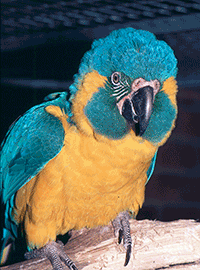 by Jim Hayward
by Jim Hayward
ORIGINAL HOMELAND:
Bolivia
NATURAL HABITAT:
Forested areas adjacent to waterways.
STATUS IN THE WILD:
Regarded as endangered and is on the DOE's Schedule One which means that breeders must obtain licences to sell their surplus stock.
STATUS IN AVICULTURE:
Rare and highly sought.
LEVEL OF KEEPER'S EXPERIENCE:
Only breeders of long experience with the commoner species of Ara should consider obtaining these macaws.
HARDINESS:
Resilient against cold as are the other large macaws, but adequate shelters should be constructed and facilities to protect against severe weather should be installed.
TYPE OF ACCOMMODATION:
If these large macaws are to be kept to be kept in ideal circumstances, a great deal of space is required; aviaries need to be built with substantial materials and be of sound construction. A large macaw can easily crush thin wire and wood can be reduced to piles of splinters and the heaviest gauge welded mesh should be used, with galvanised iron pipe or angle iron screwed or bolted together to make the framework. A walk-way around the sides of the aviary block, can be covered with a thinner gauge 1/2" x 1" mesh to prevent sparrows and other small birds from entering. Large rodents can be foiled by a 'rat skirt' of mesh or galvanised steel dug in around the boundary of the entire aviary. Shelters can be made with brick or concrete block; concrete floors should be laid in the shelters, but if used in the open flights must be constructed with a drainage system; concrete often encourages the growth of moulds and algae. An alternative to concrete floored flights on well drained land involves the removal of top soil and laying of a 6" to 1ft layer of 1/2" to 3/4" diameter pebbles or shingle.
TYPE OF DIET:
As varied as possible; as well as a mixture of large seeds and nuts, the following should be provided: grain (e.g. shot and cooked wheat), pulses (cooking is advised, if given raw some beans can be toxic and may also contain a tryptopane inhibitor which creates digestive problems), a variety of vegetables (including scalded frozen peas, cooked root crops, raw carrot and greens), tropical fruits (mango, papaya, star fruit, kiwi, etc.), cheese and small amounts of cooked lean meat or poultry, even white fish, budding willow or branches of other non toxic species, uncontaminated flowering and seeding weeds (e.g. chickweed, dandelion, sow thistle) and berries from the elder, hawthorn and rowan. Cuttlefish, grit and other suitable sources of calcium and mineral are necessary for the maintenance of the skeleton, digestion and egg production, and should be available at all times - as should clean fresh water. It is worth remembering that avocado is considered to be harmful to parrots.
SEXING:
Sexing from appearance is difficult if not impossible. Surgical sexing is generally employed to solve this problem.
SEXUAL MATURITY:
Attempts at nesting with other large macaws like these usually begin from four to five years old.
NESTING SEASON IN BRITAIN:
Attempts at nesting with other large macaws like these may occur at any time of year, from mid winter through spring summer and autumn.
TYPE OF NEST:
Aviculturists use a variety of nesting receptacles for large macaws like these including large boxes, barrels, even metal drums and dustbins - sometimes set up high and other times just laid on the floor. An initial covering for the bottom of the nest can be made of soft sieved sand and rotted wood, but pieces of wood can also be placed or fixed inside the nest for the birds to gnaw and in so doing provide extra nest litter.
USUAL NUMBER OF EGGS:
Eggs may vary from two to four, but most usually three, which are generally laid with a couple or even more days between eggs.
INCUBATION PERIOD:
From twenty-five to twenty-eight days depending on the time of year and temperature.
USUAL NUMBER OF YOUNG:
Two to three.
FLEDGING AGE:
At the age of just over three months, the young are ready to fledge the nest; they resemble their parents, apart from their slighter build, dark irides and shorter tails.
USUAL NUMBER OF CLUTCHES:
If left to breed naturally the length of the nesting/rearing cycle leaves time for only one clutch per year.
NESTING HABITS:
As with the other large macaws, breeding pairs can be fierce in defence of their nest, eggs and young. Mating can be frequent and prolonged and is carried out as the birds sit side by side - in keeping with the habits of other South American parrots. Mutual preening is part of the courtship ritual, during which the cock regurgitates food for the hen and feeds her with a pumping action.
SPECIAL CONSIDERATIONS:
Parrots as rare as the Caninde Macaw should not be considered as pets, every available specimen should be included in a breeding programme.
NOISE FACTOR:
The raucous voices of macaws can cause disputes with close neighbours and even legal proceedings, so careful consideration must be given to this potential problem before purchasing such large parrots.
PRICE RANGE:
Subject to negotiation between the parties.
AVAILABILITY:
Rarely offered for sale.
